 Readers pay attention to only about 20% of the words on a web page. They prefer to skim tables of content and subheads. They want to know if your content is worth their time and effort.
Readers pay attention to only about 20% of the words on a web page. They prefer to skim tables of content and subheads. They want to know if your content is worth their time and effort.
Add to that the mere seconds you have to grab and hold readers’ interest, and the battle for the audience may seem lost.
It is not.
An article’s introduction is an underestimated yet powerful game-changer in your content marketing arsenal. Here’s how to make this weapon work.
An article’s intro is an underestimated yet powerful game-changer in your #content arsenal, says @WritingBreeze via @CMIContent. #WritingTips Click To Tweet
Why emphasize introductions
If readers scan the content, then why bother with intros?
Readers who encounter challenging-to-scan intros that miss the what’s-in-it-for-me information may stop scanning altogether. Done well – with good hooks – an introduction can turn a scanner into a reader.
A good introduction:
- Sets expectations.
- Excites the audience, so they keep reading.
- Lets the audience know what they will get later in the content.
These seven formulas can help you achieve those good intro goals.
1. Agree, promise, preview (APP)
The APP formula does it best for a search audience so they know you can deliver what they want. Here’s how it works:
- Provide the information (a problem) a target reader would agree
- Promise a solution to that problem.
- Preview your content so they understand what they’ll get when reading.
Follow the APP method in an article’s introduction – agree, promise, and preview the #content – to retain readers, says @WritingBreeze via @CMIContent. #WritingTips. Click To Tweet
SEO expert Brian Dean of Backlinko is the author of this method. He often uses it in his blog posts as it lets him keep intros concise, straightforward, and appealing. I used APP in this guest post for Woorank:
- Agree: “Top-notch content that’s well-rounded, correctly formatted, and benefits an audience is what Google demands. Unfortunately, that’s just the base requirements. If we want to rank higher in SERPs, we need to produce high-quality content that focuses on SEO as well.”
- Promise: “Good search engine optimization is important, being more than just having a lot of keywords embedded in the content. SEO writers need to develop ways to take content to the next level, ranking higher than the competition.”
- Preview: “This article will demonstrate five practical strategies designed to help take content writing further and achieve better SEO.”

2. Attention, interest, desire, action (AIDA)
Among the most common copywriting techniques, AIDA works well for sales content, evoking the desire to purchase and pushing potential buyers to take action. It also works well for intros because it can:
- Grab the reader’s attention in the first sentence.
- Appeal to their interest by saying something new to them.
- Evoke the desire to learn more, explaining how they’ll benefit from the content.
- Invite them to take action (keep reading).
Travis Taborek implements this intro formula in his article 6 Steps To Help Content Marketers Thrive in a World With AI Content Tools:
- Attention: “Content marketers spend a lot of time pondering the question, ‘Will copywriters be replaced by AI?’ They often conclude writers don’t need to worry.”
- Interest: “But you would benefit more if you asked a different question: …”
- Desire: “ … ‘How can content writers work in a world that includes AI-created content?’”
- Action: “Take steps today to ensure your work and skills can’t be replaced by a robot.”
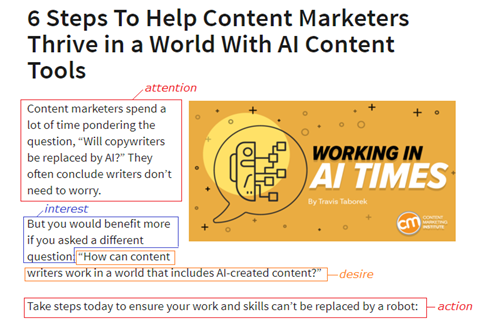
3. Preview, proof, bridge (PPB)
Backlinko’s Brian Dean also uses this formula to engage users from the first sentence and clarify whether the content is worth reading:
- Preview your content asset.
- Provide proof why it’s worth further investigation.
- Add a bridge (a short transition phrase to keep readers glued and get them to the next paragraph).
Brian’s article on blog promotion uses the PPB method:
- Preview: “In today’s post, I’m going to show you exactly how to promote your blog.”
- Proof: “These are the same strategies that I used to grow my blog to 449,058 monthly visits.”
- Bridge: “Let’s dive right in.”
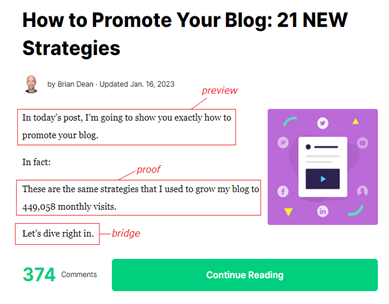
4. Short, pain, yay (SPY)
People don’t want to work hard to understand your content. Don’t frighten them with complicated sentences and long paragraphs in the introduction. Make it visually readable, punchy, and easy to digest.
Start with a short sentence that hooks the audience. How do you know what hooks readers and grabs their attention? Ask an intriguing question. Make a controversial statement. Use a quote or incorporate statistics. Include a surprising fact.
The only rule? Say something that will yay the audience – something unusual and unexpected. Whether you use a question or a statement, make it sound odd enough for readers to crave more. To cement the effect, refer to a pain point your readers might have. Communicate awareness of your targets’ problems, and you’ll gain their sympathy.
The SPY formula includes the following:
- Start with a short
- Address a pain point.
- Hook with a yay info (say something unusual or unexpected).
Helen Boss demonstrates this technique in her article for SmartBlogger:
- Short and yay: “Looking for inspiring ways to use conversion copywriting?”
- Pain point: “… But you’re struggling to understand how to win over visitors quickly before they leave your site. It’s frustrating! And, on top of that, it’s leaving you out of pocket.”
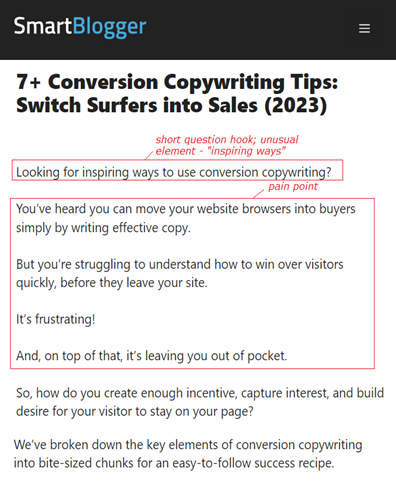
5. Socratic method
I mentioned the Socratic method in my article about neuro writing tactics. Named after the ancient Greek philosopher Socrates, it’s about asking argumentative questions to stimulate curiosity and critical thinking. Perfect to use in content introductions to hook users and create a reading flow.
But it’s not about only asking a question in the first sentence. Use at least two (ideally three) questions in a row. Ensure each is concise and contextually related to the information in the content.
Intro writing tip: Write three concise and contextually related questions in a row, says @WritingBreeze via @CMIContent. #WritingTips Click To Tweet
My writing guru Henneke Duistermaat nails it in the article, How To Turn a Sales Pitch Into a Pleasant Conversation: 3 Writing Techniques:
- “Does writing sales copy feel hard?”
- “Do you feel like you have to turn yourself into a pushy sales person?”
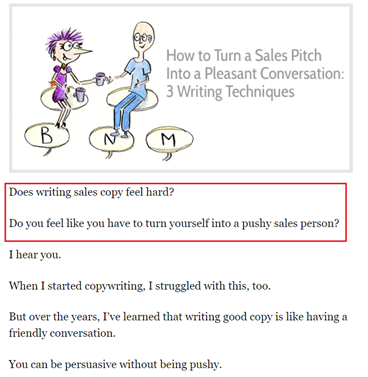
Instead of questions, you can post consecutive statements. Choose those your target readers will nod in agreement as they read. It gives them subconscious proof you understand their pain and know how to help.
Brian Clark uses the Socrates statement method in this Copyblogger article in which he says he will share how to:
- Get started
- Cut the fluff
- Finish a draft.
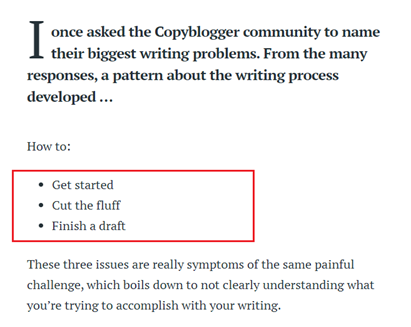
6. Concise yet emotional
The oldy-moldy powerful technique of storytelling engages readers and makes them want to keep reading. Why? Stories activate the experience-related parts of the brain.
Reading or listening to a story immerses the readers who feel more connected and related to the information shared in the story. It also keeps them wanting to see how the story progresses.
Sharing a personal story – reflective writing – in an introduction involves readers. I use this technique on Writing Breeze sometimes. For example, under the headline SEO Writing: How To Craft Content Google and Searchers Will Love, I write: “First, a confession. I’ve been in SEO writing for 10+ years …”
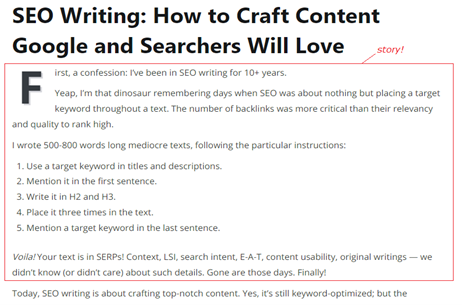
But you don’t have to go personal. You can use the Pinocchios of storytelling – fictional characters to tell a story, create emotional connections, and improve the content experience for your audience. Back to Henneke again in the article, How To Outline a Blog Post (and Create a Hypnotic Flow), who writes:
“Harry is scratching his head. He stares at his draft text, while sipping his coffee. Why does his writing feel like a mess? What is he actually trying to communicate …”

7. Scene-setting
This intro method sets a scene for the readers to prompt their curiosity and help them understand what to expect. It also works well for emerging topics or newsy issues.
With scene-setting, you can:
- Establish a clear position on the issue.
- Highlight the aspects of your content asset.
- Manipulate the reader’s emotions by setting a desired tone from the beginning.
- Address the reader’s imagination and involve them in the process of thinking.
That’s what Lesley Vos does in her article on WordStream:
“There are two magic lands. One is the land of friendly grain-grower tribes, while the other is a motherland of mean-spirited hunters warring and betraying for profit.
“Can you guess which land is called Grataka and which one is called Lamoniana?”
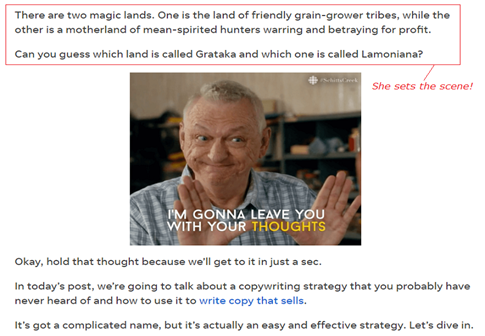
Scene-setting intros appeal to social instinct, evoke curiosity, and motivate people to keep reading to get the answer and disclose if the assumptions were correct. A well-written scene in an introduction also provides background on the topic, so readers can understand why it’s worth their time.
Which intro method motivates you to read?
Introduction writing takes time and practice to master. Formulaic methods from savvy content creators can help but don’t treat them as the ultimate truth: Follow your writing style, brand tone of voice, and target audience’s needs to create opening paragraphs they’ll be eager to read.
After you draft an intro, ask: “Would I read the article if I went through this kind of introduction?” If you answer “yes,” move on to the next paragraphs. If you answer “no” or hesitate, revise it until you’re satisfied.
Remember Hemingway’s advice: “All you have to do is write one true sentence.” Start your introduction with “the truest sentence you know,” and your reader will stay with you.
HANDPICKED RELATED CONTENT:
Cover image by Joseph Kalinowski/Content Marketing Institute




